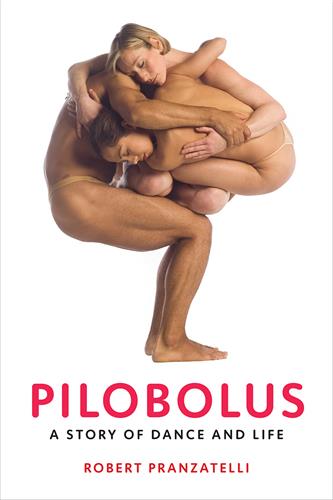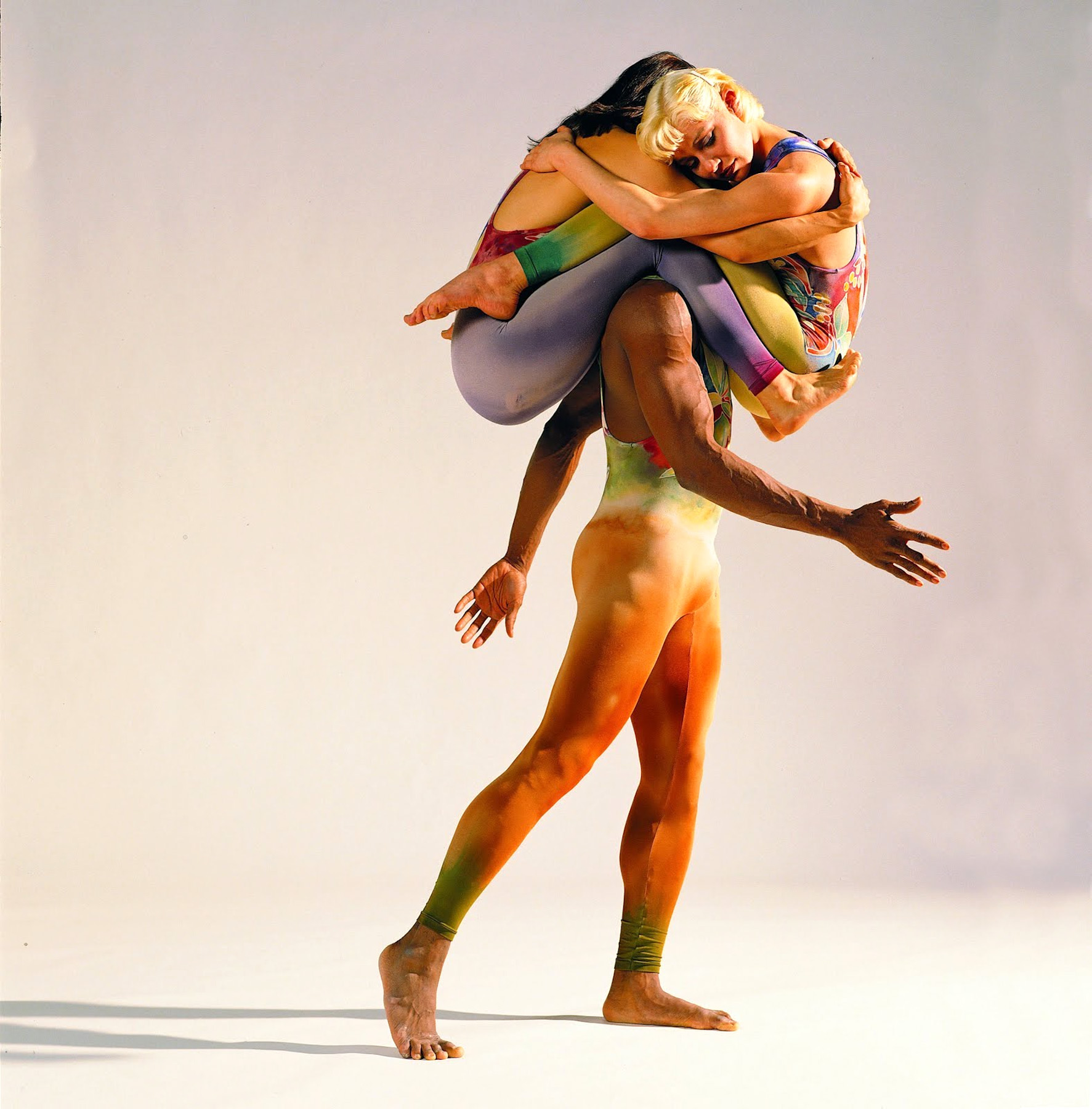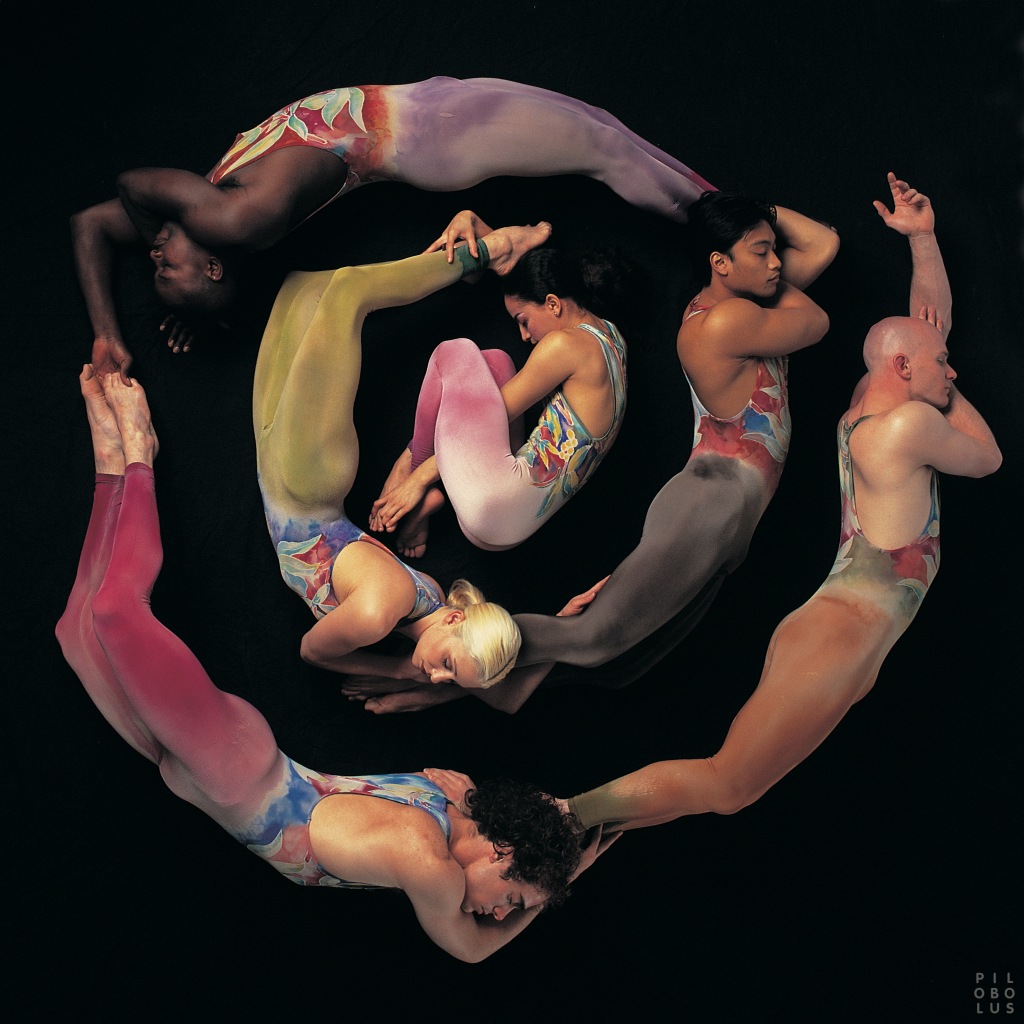
In Pilobolus: A Story of Dance and Life, author Robert Pranzatelli shares previously untold details about the dance theatre company’s history and the creation of its most significant works.
Below is an interview Robert Pranzatelli conducted with Renée Jaworski, Pilobolus’s executive/co-artistic director, and Matt Kent, the company’s artistic director. Jaworski and Kent are not only leaders of Pilobolus but also two of its veteran dancers. This interview took place in 2023 as Pilobolus was celebrating its 50th anniversary and preparing to conclude its “Big Five-OH!” anniversary tour with a run of performances at the Joyce Theater in New York. The interview first appeared on the Pilobolus website and has been edited here for length and clarity.
Robert Pranzatelli: For people who don’t already know Pilobolus, how would you describe what Pilobolus does and what people will encounter when they see this show? You’ve told me, Renée, that Pilobolus creates miniature worlds onstage.
Matt Kent: You have to get your interdimensional passports ready because you’re going to go to these very different worlds. These programs are going to have a range of emotions to them. When the dancers ran the first half of the Joyce program that has six pieces instead of five, I said “How did that feel?” and Hannah [Klinkman] turned to me and said, “I’ve been on an emotional rollercoaster.” It wasn’t a bad thing.
Renée Jaworski: When we’re putting a program together we really are thinking about just that: the ride the audience is going to go on. We want to hit the highs and the lows and the things that you don’t get in touch with on your day-to-day basis, allowing people to experience things that they wouldn’t normally pay attention to outside of the theater. So then when they walk out into their real life, there’s a little bit more of a—I want to say rawness, but that sounds negative—
Matt: No, I don’t think it’s negative—
Renée: A vulnerability, an openness.
Matt: You’re seeing things anew. You walk outside, it’s the same outside it was before, but somehow the world seems—
Renée: You might have a different perspective somehow.
Robert: That’s a good definition of what art is, or what art does.
You’re sitting in front of this wonderful painting of sunflowers, and I’m thinking about how you’re working in the studio getting ready for this run. Is there a secret ingredient as you create? What are the moments of joy in the studio in terms of camaraderie, laughter, the best moments with the dancers? Take us into some of the happier aspects of life in the studio with Pilobolus as you’re preparing for this.
Matt: That does happen to us, a particularly magical collaborative moment, but to paint the visual picture, we’re not in New York, horns, traffic, blaring. Those days that you feel the sunshine coming through or the beautiful snow falling outside and you’re working on a piece or rehearsing, that feels like we’re in some kind of residency that’s your actual life, like you’re in a retreat. There are moments that—when you said “happy”—I think about the communal, in both senses of the word, moments that we share with the dancers and with each other. I’ve walked outside with them just to get some sunshine. We’ve been trying to take these breaks every ninety minutes or so, and we all step outside and realize that we’re surrounded by this beautiful environment.
Renée: There’s also something that happens between the people. We equate it to jazz. You can tell when everybody is…
Matt: Gelling…
Renée: Gelling, or on the same vibe, or running at full speed in the same direction. And it gets very… uh…
Matt: Groovy, man?
Renée: Groovy, man.
Matt: Renée and I went to this amazing little bar in New York years and years ago. David Poe was playing there.
Renée: It was called Entwine.
Matt: Yeah, called Entwine. Chris Stills, Stephen Stills’ son, was playing. It just so happened, before we knew them, Béla Fleck and Abigail [Washburn], they performed there.
Renée: It was the first time we heard Abbie sing. We were like, Whoa!
Matt: And a bunch of people. A bunch of musicians. And unlike when somebody has a setlist and they’re planning, they would noodle and you would hear the piano and the room was filled with conversation while you waited for the guys to share with each other what they were about to play. And then the clouds would part—and it was like what I imagine when The Dead were at one of their peaks—
Renée: There’s no 1,2,3,4 boom and then everybody starts. It’s sort of like—
Matt: Yeah, the piano player keeps jamming and then that person catches on, oh I got you, and—
Renée: And then the room goes quiet and they’re in the beginning of a song and everybody knows it. Every single person in the room, whether they’re playing an instrument or not, knew that the song began.
Matt: As directors, when we’re choreographing, there are moments where the dancers really command my attention like that. When I forget that this is a thing I’m making, and I’m just absorbed in watching. They’re so beautiful, and their creativity—there are moments when you’re fully into that moment.
I think it’s important to say that another moment of joy, just to be clear, some of the times the moments of joy are right after we’ve had the worst disagreement, the dancers aren’t getting something, I can’t figure out what they’re doing wrong, one of them says that’s hurting my back, someone says I don’t know what to do. Put your foot there. That doesn’t work for me. A kind of harmony that comes out of disharmony. It’s worth noting that it’s not all just new age music and flowers blooming. There are real moments of tension and disagreement, and I personally find the days that alternate between disagreement and
agreement to be much, much more satisfying and productive. It’s nice to have those perfect days, but in terms of making a piece, I think it’s so gratifying, so joyful, when you identify something that doesn’t work between two people and you work it out.

Robert: I’ve joked with you in the past, that my idea of risk is getting out of bed in the morning. And that this is why I’m so impressed by people who do things like stand on someone else’s shoulders while they’re dancing, or dance on stilts, or swing on silks. Or stand on a stage and flip themselves over and land standing up as in Megawatt.
Renée, you told me that being able to fall like a cat that always lands on its feet is one of the skills that goes with Pilobolus, something you learned early on. What are the qualities that Pilobolus dancers most need to have?
Renée: I think the most important thing that a Pilobolus dancer needs actually has nothing to do with their physicality but is in their mindset. For lack of a better word, I’ve heard this term used lately and it may be a little trendy, but I think they need to have a “growth mindset.” Just the idea that not only they but everybody in the room has room to grow and expand, and using the term “I don’t know how to do that yet,” the idea that they can learn something new, even if they’re thirty years old, or forty, or fifty. But that you’re always listening and always curious. That leads to so many other things physically and tangibly in the work that we do, including interactions between people because you have to have a growth mindset to really push each other in an honest and healthy way, because if you think somebody can’t do something then they won’t.
Matt: Or you might not see when they’re doing it. The “growth mindset” that you’re talking about—they are group centered. The dancers can, in a physical way and in a mental way, project their center of thought or mass or weight to a midpoint between multiple individuals, minds, bodies, so that they’re able to land on their feet like a cat because they have this spherical evenness, but that body awareness has to be accompanied by their mind or their outlook or their creative output, or, as great as they may be physically, they’ll run out of tricks. It’s like my brother [a school principal] has been saying about school, that the only essential skill for our children to learn in this era is curiosity and learning, how to learn, how to love learning and how to approach learning. Their group centeredness is part of that. For the choreographers, artistic directors of Pilobolus, we need to work with people who will present to us solutions that might not be obvious at first, which is why we sometimes madden people who don’t know us by giving them tasks that don’t have an answer that we already know.

Robert: Let’s talk about comedy. The first time I ever saw Matt he was onstage getting stepped on and walked over by his colleagues, in Walklyndon. You’ve got that piece and Solo from The Empty Suitor, both of which are vaudevillian and slapstick in nature, and which date from 1971 and 1980 respectively. They’ve been making audiences laugh across a half century, which is quite extraordinary. Both are examples of nonverbal, physical comedy—one with comic encounters between pedestrians and the other with a guy slipping and sliding on PVC pipes—and they have a kind of universality, but what else keeps them clicking? Comedy and dance are both about timing, that’s a common denominator. Or is it just that these are machines that were built right, from the beginning, and they keep working?
Renée: It might be a little bit of a mixture. I think it’s more—I think they change a lot, actually, Rob. The structure of those two particular pieces, the structure is funny, the structure is comedic, but it does change quite a bit in terms of what you’re talking about, timing and rhythm, and all of those other much more personal performer type elements, do change quite a bit.
Matt: I would say it like this. Both Walklyndon and Suitor are pieces that more than any others will be different every time you see them. You never see it the same way twice. From Looney Tunes back to Punch & Judy to probably way before that, watching two people run head-on into each other for some reason always makes people laugh. It’s like it’s just in our DNA. Watching a guy try and navigate these rollers is inherently funny, but then coupled with that we work a lot on timing and the performers have to approach the piece as a living thing and listen to the audience and change it according to whatever’s going on.
Robert: And there is something psychological about that kind of comedy where what is happening is either dangerous or physically harmful but because we’re in the audience and we know it’s comedy, that makes it fun. It’s like power over the things in life that actually are not fun.
Renée: Right.
Robert: From being a dancer to being a director, what do you each now see from your own past that most influences or assists you as you guide Pilobolus forward?
Renée: You know, I think as a dancer I worked really, really hard to see and take the positive things that came out of collaboration and make them bigger and better to drown out the negative things that were happening. And that practice of doing that, with the directors when they were being contentious [with one another] or not trying to work through something together so we had to work through it on our own.
Matt: Yeah, I was going to say something similar, and you’re putting it just perfectly. The perspective that you’re pointing out is that because we were dancers, with Pilobolus directors directing us collaboratively in real time—an experience that the founding directors did not have—it makes us better collaborative directors because there are certain things that you can only see from the outside. And we saw from the outside, like, “Oh, hmm…”
With the gift of this longevity, first of all we have more data, more data points to look at and make decisions. We’re sort of all Pilobolus and yet—We care for this thing like a living thing but we have a different perspective that has helped us. We aren’t trying to copy the founding directors of Pilobolus. There are things we admire and therefore want to emulate but mostly we’re trying to be the best us that we can be. And we’ve danced together. We were partners a lot, and that helps immensely.
To read the full interview, which includes discussion of pieces performed on the anniversary tour, click here.
For more information about the book, watch the book trailer below. The book is available to order on the University Press of Florida website here. Use code 24SPR for discount prices through June 30, 2024.
